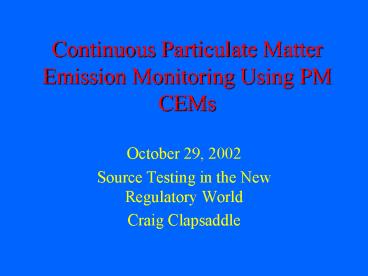Continuous Particulate Matter Emission Monitoring Using PM CEMs - PowerPoint PPT Presentation
1 / 21
Title:
Continuous Particulate Matter Emission Monitoring Using PM CEMs
Description:
Can be upgraded from CAM to continuous compliance monitoring. PS-11 ... Will allow States and Regions to use better monitoring of PM emissions than opacity ... – PowerPoint PPT presentation
Number of Views:1163
Avg rating:3.0/5.0
Title: Continuous Particulate Matter Emission Monitoring Using PM CEMs
1
Continuous Particulate Matter Emission Monitoring
Using PM CEMs
- October 29, 2002
- Source Testing in the New Regulatory World
- Craig Clapsaddle
2
Topics to Cover Today
- Why are PM CEMs important
- Historical development/use of PM CEMs
- Types of PM CEMs
- Advantages/disadvantages
- PS-11 and Procedure 2
3
Why are PM CEMs Important?
- Opacity correlates poorly to PM emissions
- No less than 14 NSPS have opacity monitoring
- All States have opacity monitoring
- PM CEMs can address the shortfalls of COMs
- Title V CAM plans
- Scrubbed stack PM monitoring
- New coal-fired power plant permits
- Technology now available to measure PM emissions
in units of the standard
4
Historical Perspective
- 1964 German Federal Law for Citizens
- Continuous PM monitoring of industrial plants
- No monitors were yet available
- Started monitor development and field study
- 1974 German Federal Law of Env. Protection
- 1983 German power plants
- 1990 German waste incinerators
5
Historical Perspective (B)
- 1970s U.S. EPA does several correlation studies
- 1975 EPA Promulgates PS-1 for opacity
- 1976-77 University of Windsor field study
- 2 opacity monitors
- 1 light scatter monitor
- 1 charge transfer monitor
- 1 beta gauge monitor
- 1980 Last EPA funded study on PM mass conc
monitor
6
Historical Perspective (C)
- 1995 EPA OSWER begins looking at PM CEMs for
HWC MACT - 3 field evaluations
- Proposed PS-11 in April 1996
- 1997 EPA OSWER NODA
- Second proposed PS-11 in Dec. 1997
7
Historical Perspective (D)
- 1999 EPA OAQPS EMC does field study
- 2001 EPA reproposes PS-11 in Dec.
- 2002 Comments and public hearing
- Promulgate a final PS-11 and Procedure 2?
8
Types of PM CEMs
- Light scatter
- Forward, side, backward
- Beta Attenuation
- Probe Electrification (charge transfer)
- Light Extinction (opacity)
- Optical Scintillation
9
Light Scatter PM CEMs
- Sigrist KTNR CTNR
- Durag DR-300-40
- ESC P5
- Sick RM210, FW 100, FWE 200
- Grimm Technology 6300
- ML 300L
10
Beta Attenuation PM CEMs
- MSI BetaGuard PM
- Durag F904K
- Environment S.A. 5M
11
Probe Electrification
- PCME DustAlert
- Auburn Triboguard
- Codel StakGard
12
Optical Scintillation
- BHA CPM 5000
- PCME Scintilla SC600
13
Opacity
- Land Combustion 4500
- Durag DR-280 and 290
- KVB Enertec MIP
- ML/USI 560
- Rosemount OPM 2000R
- Phoenix OPAC 20/20
- Sick OMD41
- TECO 440
14
Light Scatter Adv./Disadv.
- Low price 10-15,000
- Easy to install
- Low maintenance
- Sensitive to low PM concentration
- Effective after FF or multi-stage APC
- Measures secondary properties of PM
- Adversely affected by
- Particle size, density, shape change
- IR light better than visible light
- Measures liquid drops as PM cant be used after
a scrubber
15
Beta Attenuation Adv./Disadv.
- Direct measure of PM concentration
- Not affected by particle characteristic changes
- Designed to work in wet stack applications
- More difficult to install
- Expensive 60-90,000
- Higher cost of ownership
- Sample extraction and transport
16
Probe Electrification Adv./Disadv.
- Inexpensive 5 10,000
- Simple to install
- Sensitive to low PM concentration
- Effective as bag leak detectors
- Adversely affected by
- Particle charge (not after an ESP)
- Particle size and velocity changes
- Measures liquid drops as PM
17
Opacity Adv./Disadv.
- 10,000 already installed
- Measures attenuation of light
- Adversely affected by
- Particle size, shape, density changes
- Measures liquid drops as PM
- Not sensitive to low PM concentration
- Cost more than a light scatter PM CEM
- Correlation to mass conc. not linear
18
Optical Scintillation Adv./Disadv.
- Low price 10,000
- Easy to install
- Low maintenance
- Not sensitive to low PM concentration
- Doesnt detect particles lt 2µm
- Adversely affected by particle density change
- Measures liquid drops as PM
19
Title V CAM for PM
- Advantages of a PM CEM for CAM
- Most flexibility for process and control
equipment operation - A direct measure of pollutant of interest
- Measures real not probable excess emissions
- Can be upgraded from CAM to continuous compliance
monitoring
20
PS-11
- Gives guidelines for selecting a PM CEM
- Gives installation location guidance
- Gives procedures for certifying a PM CEM
- Gives minimum performance limits
- Gives example calculations
- Will allow States and Regions to use better
monitoring of PM emissions than opacity
21
Procedure 2
- Gives ongoing QC procedures for PM CEM
- Daily drift checks
- Quarterly audits (ACA and SVA)
- Annual check of correlation (RRA)
- Procedure for full verification of correlation
(RCA)

